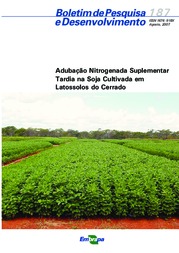Adubação nitrogenada suplementar tardia na soja cultivada em latossolos de Cerrado.
Adubação nitrogenada suplementar tardia na soja cultivada em latossolos de Cerrado.
Author(s): MENDES, I. de C.; REIS JÚNIOR, F. B. dos; HUNGRIA, M.; SOUSA, D. M. G. de; CAMPO, R. J.; AGUIAR, J. L. P.; SOUSA, T. C. R. de
Summary: RESUMO: Foi avaliado o efeito da suplementação tardia (pré-florescimento e início do enchimento de grãos) com diferentes fonte de adubo nitrogenado (uréia, nitrato de amônio e sulfato de amônio) no rendimento da soja cultivada em latossolos de Cerrado. Quinze experimentos foram conduzidos na Embrapa Cerrados, no período de 2000 a 2005, em latossolos com populações estabelecidas de Bradyrhizobium capazes de nodular a soja. Em apenas dois experimentos, a resposta da soja à adubação tardia com nitrogênio foi estatisticamente significativa. Considerando-se o custo do adubo nitrogenado e o preço da soja, foi verificado que a adubação tardia com nitrogênio não acarreta nenhum lucro para os produtores, já que o custo de produção com adoção dessa prática supera as receitas. Os resultados obtidos reforçam os benefícios econômicos que resultam da substituição dos fertilizantes nitrogenados pela inoculação e indicam, claramente, que não existe razão para a utilização de fertilizantes nitrogenados em nenhum estágio do cultivo da soja em latossolos do Cerrado. ABSTRACT: The expansion no tillage systems in the Cerrados region, the release of cultivars with high yield potential and some results obtained in US, regarding soybean yield responses to late season N applications, have generated questions about the need to use this practice for soybeans grown under tropical conditions. This work examined the effects of late season (pre-flowering and grain filling) Nitrogen fertilizer on soybean yields, grown in Cerrado oxisols. Fifteen experiments were carried out over a five year period (200-2005), at Embrapa Cerrados, Planaltina, DF, in oxisols with established Bradyrhizobium populations able to nodulate soybeans. The six treatments evaluated were: Innoculated (SEMIA 5079 and 5080, Bradyrhizobium japonicum strains) controls without or with 200 kg of N urea ha (elevado a -1) (split twice), and inoculation with N fertilizer (ammonium nitrate and ammonium sulfate) applied at the R1 or R5 stage (50 kg of N ha (elevado a -1)). Out of the fifteen experiments, in only two the yield responses to late season N applications were significant. Considering the results obtained, the cost of N fertilizers and soybean prices, late season N applications do not result in any economical benefit. The results evidenced, once more, that there is no reason to use N fertilizers in soybeans grown under the Brazilian Cerrados conditons.
Publication year: 2007
Types of publication: Booklets
Unit: Embrapa Cerrados
Related content
Technologies See more
Observation
Some of Embrapa's publications are published as ePub files. To read them, use or download one of the following free software options to your computer or mobile device. Android: Google Play Books; IOS: iBooks; Windows and Linux: Calibre.
Access other publications
Access the Agricultural Research Database (BDPA) to consult Embrapa's full library collection and records.
Visit Embrapa Bookstore to purchase books and other publications sold by Embrapa.



